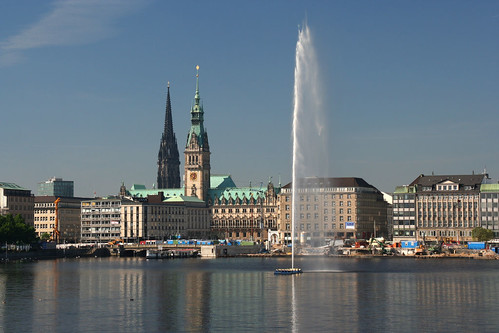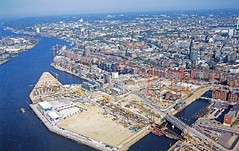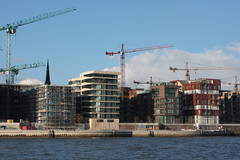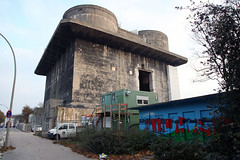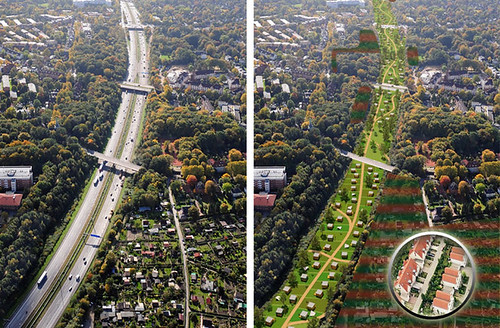How Hamburg became the European Green Capital

Posted November 21, 2011 at 1:30PM
Last year the European Union began honoring cities for exemplary environmental efforts by designating one each year as the “European Green Capital.” Stockholm won the designation for 2010, and Hamburg won it for 2011. The tenth largest city in Europe (city population 1.8 million, metro area 4.3 million), Hamburg earned the award by showing that it had both a typical range of urban environmental challenges and an ambitious program of solutions for addressing them.
I am particularly impressed that Hamburg’s application led with redevelopment, demonstrating that the city is directing growth inward. HafenCity Hamburg, for example, is Europe’s largest city development project, on 388 acres of former industrial land in between Hamburg’s downtown and the Elbe river. When completed, it will add 5,500 homes (some subsidized to be affordable) along with shops, parks, entertainment, schools and daycare, offices, and a university on what has basically been a massive brownfield. All, of course, will be walkable, transit-accessible, and compliant with the city’s green building standards. (Below left, project site; right, HafenCity under construction)
Meanwhile, across the river, the Wilhemsburg quarter, home to some 50,000 residents from 27 countries, is being transformed into a showcase of green redevelopment. Christopher Scheutze writes in The New York Times:
“A second set of projects seeks to remake one of the most struggling parts of the city through urban densification on an island called Wilhelmsburg, across the Elbe River south of HafenCity. Hamburg is funding both environmentally and socially conscious building projects with a view to stoking a vibrant community life, a more efficient urban infrastructure and greener living. The goal is to improve the quality of life and attract new residents.
“By embracing largely experimental design, city leaders hope to transform an area shared by factories, a garbage dump, the working harbor, public housing, and mostly working-class Turkish immigrant neighborhoods, into a model of so-called green community living.”
(I’m not sure why Scheutze felt the need to drop the pejorative “so-called” in there, given that he clearly approves of the project.)
Mark Boyer notes in Inhabitat that the Wilhelmsburg project includes conversion of an ugly, 130-foot-tall concrete bomb shelter (above), built during World War Two, into a renewable energy power plant that will serve 3,000 households. Boyer writes that a heating and power system fueled by wood chips will begin operation inside the structure next year, followed by the installation of 30,000 square feet of solar panels on the exterior.
Hamburg's most visually dramatic green project, though, may be the plan to cap a two-mile stretch of a major freeway with woods, parks, trails, and garden plots for city residents. The green cap, which will also reconnect neighborhoods split by the freeway, will be over 100 feet wide and as much as ten feet thick in places.
Hamburg is also one of Europe's busiest industrial ports, and greening the port is a key part of the city's environmental agenda. Central to the concept is the use of “container taxis” on the river that, the city says, will each displace 60 trucks from point to point, substantially reducing pollution. 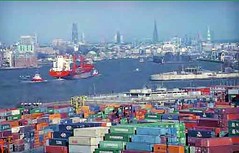 The port authority is also reducing fees for ships that meet environmental standards.
The port authority is also reducing fees for ships that meet environmental standards.
For passenger transportation, Hamburg is expanding its public transit system with a new light rail line expected to be operational in 2014. The city is aiming through these and other measures, including building standards, to reduce carbon emissions 40 percent by 2020 (the EU standard) and 80 percent by 2050 from 1990 levels.
Next year, the Basque city Vitoria-Gasteiz will be the European Green Capital, followed in 2013 by Nantes.
One of the most fun things to emerge from Hamburg’s term has been the “Train of Ideas,” a traveling exhibit of interactive environmental innovation and education that went from Hamburg to quite a few European cities before returning home. Check it out in this video (parts in German, but mostly in English):
Move your cursor over the images for credit information.
